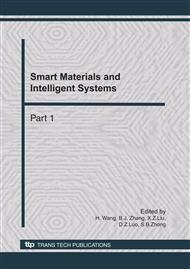[1]
D. Feng, S. C. Huang, and X. Wang, Models for computer simulation studies of input functions for tracer kinetic modeling with positron emission tomography, Int J Biomed Comput, vol. 32, pp.95-110, Mar (1993).
DOI: 10.1016/0020-7101(93)90049-c
Google Scholar
[2]
K. P. Lin, S. C. Huang, Y. Choi, R. C. Brunken, H. R. Schelbert, and M. E. Phelps, Correction of spillover radioactivities for estimation of the blood time-activity curve from the imaged LV chamber in cardiac dynamic FDG PET studies, Phys Med Biol, vol. 40, pp.629-42, Apr (1995).
DOI: 10.1088/0031-9155/40/4/009
Google Scholar
[3]
Y. H. Fang, et al, Spillover and partial-volume correction for image-derived input functions for small-animal 18F-FDG PET studies, J Nucl Med, vol. 49, pp.606-14, Apr (2008).
DOI: 10.2967/jnumed.107.047613
Google Scholar
[4]
W. Koon-Pong, et al, Segmentation of dynamic PET images using cluster analysis, Nuclear Science, IEEE Transactions on, vol. 49, pp.200-207, (2002).
DOI: 10.1109/tns.2002.998752
Google Scholar
[5]
K. Jinman, et al, Segmentation of VOI From Multidimensional Dynamic PET Images by Integrating Spatial and Temporal Features, Information Technology in Biomedicine, IEEE Transactions on, vol. 10, pp.637-646, (2006).
DOI: 10.1109/titb.2006.874192
Google Scholar
[6]
P. Zanotti-Fregonara, R. Maroy, et al, Comparison of 3 methods of automated internal carotid segmentation in human brain PET studies: application to the estimation of arterial input function, J Nucl Med, vol. 50, pp.461-7, Mar (2009).
DOI: 10.2967/jnumed.108.059642
Google Scholar
[7]
D. W. Montgomery, A. Amira, and H. Zaidi, Fully automated segmentation of oncological PET volumes using a combined multiscale and statistical model, Med Phys, vol. 34, pp.722-36, Feb (2007).
DOI: 10.1118/1.2432404
Google Scholar
[8]
B. Dogdas, D. Stout, A. F. Chatziioannou, and R. M. Leahy, Digimouse: a 3D whole body mouse atlas from CT and cryosection data, Phys Med Biol, vol. 52, pp.577-87, Feb 7 (2007).
DOI: 10.1088/0031-9155/52/3/003
Google Scholar
[9]
Y. Zhou and J. Bai, Multiple Abdominal Organ Segmentation: An Atlas-Based Fuzzy Connectedness Approach, Information Technology in Biomedicine, IEEE Transactions on, vol. 11, pp.348-352, (2007).
DOI: 10.1109/titb.2007.892695
Google Scholar
[10]
S. Klein, M. Staring, and J. P. W. Pluim, Evaluation of Optimization Methods for Nonrigid Medical Image Registration Using Mutual Information and B-Splines, Image Processing, IEEE Transactions on, vol. 16, pp.2879-2890, (2007).
DOI: 10.1109/tip.2007.909412
Google Scholar
[11]
F. Maes, D. Vandermeulen, and P. Suetens, Comparative evaluation of multiresolution optimization strategies for multimodality image registration by maximization of mutual information, Medical Image Analysis, vol. 3, pp.373-386, (1999).
DOI: 10.1016/s1361-8415(99)80030-9
Google Scholar
[12]
J. Kybic and M. Unser, Fast parametric elastic image registration, Image Processing, IEEE Transactions on, vol. 12, pp.1427-1442, (2003).
DOI: 10.1109/tip.2003.813139
Google Scholar
[13]
J. Krivokapich, S. C. Huang, M. E. Phelps, J. R. Barrio, C. R. Watanabe, C. E. Selin, and K. I. Shine, Estimation of rabbit myocardial metabolic rate for glucose using fluorodeoxyglucose, Am J Physiol, vol. 243, pp. H884-95, Dec (1982).
DOI: 10.1152/ajpheart.1982.243.6.h884
Google Scholar
[14]
R. F. Muzic, Jr. and S. Cornelius, COMKAT: compartment model kinetic analysis tool, J Nucl Med, vol. 42, pp.636-45, Apr (2001).
Google Scholar
[15]
J. van den Hoff, W. Burchert, W. Muller-Schauenburg, G. J. Meyer, and H. Hundeshagen, Accurate local blood flow measurements with dynamic PET: fast determination of input function delay and dispersion by multilinear minimization, J Nucl Med, vol. 34, pp.1770-7, Oct (1993).
Google Scholar
[16]
P. L. Chow, D. B. Stout, E. Komisopoulou, and A. F. Chatziioannou, A method of image registration for small animal, multi-modality imaging, Phys Med Biol, vol. 51, pp.379-90, Jan 21 (2006).
DOI: 10.1088/0031-9155/51/2/013
Google Scholar
[17]
H. -M. Wu, G. Sui, C. -C. Lee, M. L. Prins, W. Ladno, H. -D. Lin, A. S. Yu, M. E. Phelps, and S. -C. Huang, In Vivo Quantitation of Glucose Metabolism in Mice Using Small-Animal PET and a Microfluidic Device, J Nucl Med, vol. 48, pp.837-845, May 1, 2007 (2007).
DOI: 10.2967/jnumed.106.038182
Google Scholar


